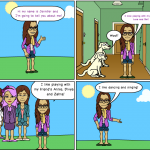I recently created an account on Bitstrips for Schools. Bitstrips is a free website where students can create comics or other graphic texts. Creating an account is easy. Bitstrips provides you with an access code that you share with your students. Students simply log in with the access code and they immediately have access to the different activities you create. Their first task (and yours) is to create an avatar. Students can then begin to work on the activities you create.

My initial activity was an introductory activity where students were asked to create a comic introducing themselves to the class. The learning goal for this activity was for students to become familiar with the comic building tools. After a week of in class work, Bitstrips is now an activity students have an option to go to when other work has been completed or they can work on activities from their home computers. Now, most of my students are completing the graphic text activities at home for ‘homework’. Parents appreciate that their children are using the Internet to complete school activities rather than to play games and watch videos on YouTube.

What I appreciate most about this website is that all students, regardless of abilities, can navigate the tools and create a piece of writing. Once students complete an activity, it must be submitted to me for review before it can be published. I can access student writing from anywhere; smart phone, tablet, at home, or school and I can give them timely specific feedback on their written submission. I am using Bitstrips to reinforce punctuation and spelling with my third grade students. I spend a few minutes each evening sending students feedback on their submissions. The next time students log in to Bitstrips they will see my feedback and they can immediately edit and/or revise their work and resend it to me for another review.
Below are some sample comments I have submitted to students:
Hi Charlie,
This is a fun comic! Please make sure you begin each sentence with a capital and end with a period.
Hi Krisandrew,
I really like how you ended your comic! I am impressed with all your slides. Please review for punctuation. For example, sentences must begin with a capital. Example “Me too.” You missed a period in one of your thought bubbles. It is movies not movie. Otherwise, great effort! Please correct and resubmit.
Below are two activities I have assigned on Bitstrips.com:
Turning Narratives Into Graphic Texts
You are to select one of your personal narratives and create a Bitstrip.
You are to use speech bubbles for your dialogue sentences.
You are to use thought bubbles for your thinking and feeling sentences.
You are to use captions for your action sentences.
Your bitstrip should meet the success criteria for personal narratives!
Silly Story Comic
You are to write a silly story!
You are to use the success criteria for a personal narrative. That is,
-Action, dialogue and thought sentences;
-Beginning, Middle and End;
-Correct punctuation and spelling;
But your story must also include the characteristics of a silly story:
-Strange and impossible events take place;
– Characters act as if everything is normal;
-You leave the reader with a smile on their face.
Your story should be a at least 5 frames long.
Dialogue sentences must be in speech bubbles.
Thinking/Feeling sentences are in thought bubbles.
Action sentences must be in captions a the top or bottom of the frame.
I am fortunate to have unlimited access to computers throughout the school day, but you can do this in a one computer classroom. As I mentioned in a prior blog post, it is important to know what access your students have to the Internet from home before you encourage Bitstrips as a homework activity. Bitstrips has helped me engage students in the writing process. It forces them pay attention to writing conventions and it provides me with a manageable way to provide timely feedback to students.






